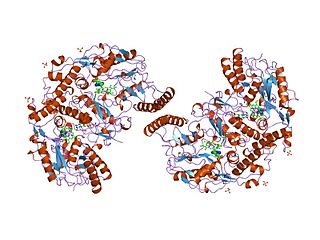Related Research Articles

Perforin-1 is a protein that in humans is encoded by the PRF1 gene and the Prf1 gene in mice.
Pemberton's sign was named after Hugh Pemberton, who characterized it in 1946.
Pancytopenia is a medical condition in which there is significant reduction in the number of almost all blood cells.

Etoposide, sold under the brand name Vepesid among others, is a chemotherapy medication used for the treatments of a number of types of cancer including testicular cancer, lung cancer, lymphoma, leukemia, neuroblastoma, and ovarian cancer. It is also used for hemophagocytic lymphohistiocytosis. It is used by mouth or injection into a vein.
Lymphoproliferative disorders (LPDs) refer to a specific class of diagnoses, comprising a group of several conditions, in which lymphocytes are produced in excessive quantities. These disorders primarily present in patients who have a compromised immune system. Due to this factor, there are instances of these conditions being equated with "immunoproliferative disorders"; although, in terms of nomenclature, lymphoproliferative disorders are a subclass of immunoproliferative disorders—along with hypergammaglobulinemia and paraproteinemias.
Malignant histiocytosis is a rare hereditary disease found in the Bernese Mountain Dog and humans, characterized by histiocytic infiltration of the lungs and lymph nodes. The liver, spleen, and central nervous system can also be affected. Histiocytes are a component of the immune system that proliferate abnormally in this disease. In addition to its importance in veterinary medicine, the condition is also important in human pathology.
Macrophage activation syndrome is a severe, potentially life-threatening, complication of several chronic rheumatic diseases of childhood. It occurs most commonly with systemic-onset juvenile idiopathic arthritis (SoJIA). In addition, MAS has been described in association with systemic lupus erythematosus (SLE), Kawasaki disease, and adult-onset Still's disease. It is thought to be closely related and pathophysiologically very similar to reactive (secondary) hemophagocytic lymphohistiocytosis (HLH). The incidence of MAS is unknown as there is a wide spectrum of clinical manifestations, and episodes may remain unrecognized.

In hematology, hemophagocytic lymphohistiocytosis (HLH), also known as haemophagocytic lymphohistiocytosis, and hemophagocytic or haemophagocytic syndrome, is an uncommon hematologic disorder seen more often in children than in adults. It is a life-threatening disease of severe hyperinflammation caused by uncontrolled proliferation of benign lymphocytes and macrophages that secrete high amounts of inflammatory cytokines. It is classified as one of the cytokine storm syndromes. There are inherited and non-inherited (acquired) causes of HLH.
HLH may refer to:

Hemophagocytosis is a dangerous form of phagocytosis in which histiocytes engulf red blood cells, white blood cells, platelets, and their precursors in bone marrow and other tissues.

Syntaxin 11, also known as STX11, is a human gene that is a member of the t-SNARE family.

Protein unc-13 homolog D, also known as munc13-4, is a protein that in humans is encoded by the UNC13D gene.

Nitric oxide synthase, inducible is an enzyme which is encoded by the NOS2 gene in humans and mice.
X-linked lymphoproliferative disease is a lymphoproliferative disorder, usually caused by SH2DIA gene mutations in males. XLP-positive individuals experience immune system deficiencies that render them unable to effectively respond to the Epstein-Barr virus (EBV), a common virus in humans that typically induces mild symptoms or infectious mononucleosis (IM) in patients. There are two currently known variations of the disorder, known as XLP1 and XLP2. XLP1 is estimated to occur in approximately one in every million males, while XLP2 is rarer, estimated to occur in one of every five million males. Due to therapies such as chemotherapy and stem cell transplants, the survival rate of XLP1 has increased dramatically since its discovery in the 1970s.
Hematologic diseases are disorders which primarily affect the blood and blood-forming organs. Hematologic diseases include rare genetic disorders, anemia, HIV, sickle cell disease and complications from chemotherapy or transfusions.
FHL may refer to:
Novimmune is a privately held Swiss pharmaceutical development company focusing on monoclonal antibody therapies for treatment of immune-related diseases. The company was founded in 1998.
Emapalumab, sold under the brand name Gamifant, is an anti-interferon-gamma (IFNγ) antibody medication used for the treatment of hemophagocytic lymphohistiocytosis (HLH), which has no cure.

Zinc finger NFX1-type containing 1 is a protein that in humans is encoded by the ZNFX1 gene.
References
- ↑ "HPLH1 hemophagocytic lymphohistiocytosis 1 [Homo sapiens (human)] - Gene - NCBI". www.ncbi.nlm.nih.gov. Retrieved 2024-06-06.